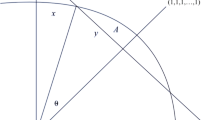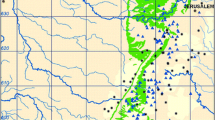Abstract
Archaeologists routinely analyse bivariate data, whether in raw form or as output from principal components or discriminant function analyses. Often, the aim is to test hypotheses regarding the relationships between two or more groups of data. This paper demonstrates two techniques that are rarely used in archaeology yet, together, refine the presentation and testing of such relationships. Confidence ellipses provide statistically meaningful summaries of location and dispersion, and allow the analyst to judge the feasibility of hypotheses. Permutation tests provide analogues of parametric statistics but do not require the sampling or distributional assumptions that such tests demand; further to this, they have greater statistical power than non-parametric statistics. The value of these two methods in combination is illustrated via a case study of stable isotope ratio data.





Similar content being viewed by others
References
Box GEP (1953) Non-normality and tests on variances. Biometrika 40(3–4):318–335. doi:10.2307/2333350
Box GEP, Andersen SL (1955) Permutation theory in the derivation of robust criteria and the study of departures from assumption. J R Stat Soc Ser B 17(1):1–34
Bradley JV (1960) Distribution-free statistical tests. Prentice Hall, Englewood Cliffs NJ
Brown MB, Forsythe AB (1974) Robust tests for equality of variances. J Am Stat Assoc 69(346):364–367. doi:10.2307/2285659
Chew V (1966) Confidence, prediction, and tolerance regions for multivariate normal distributions. J Am Stat Assoc 61(315):605. doi:10.2307/2282774
Chung JH, Fraser DAS (1958) Randomization tests for a multivariate 2-sample problem. J Am Stat Assoc 53(283):729–735. doi:10.2307/2282050
Cleveland WS (1985) The elements of graphing data. Wadsworth, Monterey
Cobb GW (2007) The introductory statistics course: a Ptolemaic curriculum. Technol Innov Stat Educ 1:1–15
Dobson SD (2005) Are the differences between Stw 431 (Australopithecus africanus) and AL 288–1 (A. afarensis) significant? J Hum Evol 49(1):143–154. doi:10.1016/j.jhevol.2005.04.001
Dwass M (1957) Modified randomization tests for nonparametric hypotheses. Ann Math Stat 28(1):181–187. doi:10.1214/aoms/1177707045
Edgington ES (1995) Randomization tests, 3rd edn. Marcel Dekker, Inc., New York
Ernst MD (2004) Permutation methods: A basis for exact inference. Stat Sci 19(4):676–685. doi:10.1214/088342304000000396
Evin A, Cucchi T, Cardini A, Vidarsdottir US, Larson G, Dobney K (2013) The long and winding road: identifying pig domestication through molar size and shape. J Archaeol Sci 40(1):735–743. doi:10.1016/j.jas.2012.08.005
Fisher RA (1919) A mathematical examination of the methods of determining the accuracy of an observation by the mean error, and by the mean square error. Mon Not R Astron Soc 80(1):758–770
Fisher RA (1935) The design of experiments. Oliver and Boyd, Edinburgh
Fisher RA (1936) "The coefficient of racial likeness" and the future of craniometry. J R Anthropol Inst 66:57–63. doi:10.2307/2844116
Galton F (1886) Regression towards mediocrity in hereditary stature. J Anthropol Inst G B Irel 15:246–263
Hammer O, Harper D (2006) Paleontological statistics. Blackwell Publishing, Oxford
Harmon E (2009) Size and shape variation in the proximal femur of Australopithecus africanus. J Hum Evol 56(6):551–559. doi:10.1016/j.jhevol.2009.01.002
Hawks J (2011) No brain expansion in Australopithecus boisei. Am J Phys Anthropol 146(2):155–160. doi:10.1002/ajpa.21420
Higgins JJ (2004) An introduction to modem nonparametric statistics. Brooks and Cole, Pacific Grove
Hotelling H (1931) The generalization of Student’s ratio. Ann Math Stat 2:360–378. doi:10.1214/aoms/1177732979
Jones H (1937) Some geometrical considerations in the general theory of fitting lines and planes. Metron 13:21–30
Kempthorne O (1955) The randomization theory of experimental inference. J Am Stat Assoc 50(271):946–967. doi:10.2307/2281178
Lehmann EL (1975) Nonparametrics: statistical methods based on ranks. Holden-Day, San Francisco
Levene H (1960) Robust tests for equality of variances. In: Olkin I, Ghurye SG, Hoeffding W, Madow WG, Mann HB (eds) Contributions to Probability and Statistics: Essays in Honor of Harold Hotelling. Stanford University Press, Stanford, pp 278–292
Lockwood CA, Richmond BG, Jungers WL, Kimbel WH (1996) Randomization procedures and sexual dimorphism in Australopithecus afarensis. J Hum Evol 31(6):537–548. doi:10.1006/jhev.1996.0078
Manly BFJ (1996) The statistical analysis of artefacts in graves: presence and absence data. J Archaeol Sci 23(4):473–484. doi:10.1006/jasc.1996.0045
Miller RG (1968) Jackknifing variances. Ann Math Stat 39(2):567–582. doi:10.1214/aoms/1177698418
O’Brien RG (1981) A simple test for variance effects in experimental designs. Psychol Bull 89(3):570–574. doi:10.1037/0033-2909.89.3.570
Pearson K (1901) On lines and planes of closest fit to systems of points in space. Philos Mag 2(7–12):559–572
Pearson JA, Buitenhuis H, Hedges REM, Martin L, Russell N, Twiss KC (2007) New light on early caprine herding strategies from isotope analysis: a case study from Neolithic Anatolia. J Archaeol Sci 34(12):2170–2179. doi:10.1016/j.jas.2007.09.001
Pitman EJG (1937) Significance tests which may be applied to samples from any populations. Suppl J R Stat Soc 4(1):119–130. doi:10.2307/2984124
Pitman EJG (1939) The estimation of the location and scale parameters of a continuous population of any given form. Biometrika 30:391–421. doi:10.2307/2332656
Richmond BG, Jungers WL (1995) Size variation and sexual dimorphism in Australopithecus afarensis and living hominoids. J Hum Evol 29(3):229–245. doi:10.1006/jhev.1995.1058
Shewhart WA (1931) Economic control of quality of manufactured product. Van Nostrand, New York
Sokal RR, Rohlf FJ (1995) Biometry, 3rd edn. W.H.Freeman and Company, New York
Tufte ER (1990) Envisioning information. Graphics Press, Cheshire
Villmoare B (2005) Metric and non-metric randomization methods, geographic variation, and the single-species hypothesis for Asian and African Homo erectus. J Hum Evol 49(6):680–701. doi:10.1016/j.jhevol.2005.07.005
Wardop R (1994) Statistics: learning in the presence of variation. William C. Brown, Dubuque
Acknowledgments
We would like to thank Ken Kahn of Oxford University Computing Services for bringing to our attention the article by Cobb (2007), and for valuable discussions of the pedagogical value of simulation methodologies. The comments of two AAS reviewers improved and clarified several aspects of the paper.
Author information
Authors and Affiliations
Corresponding author
Electronic supplementary material
Below is the link to the electronic supplementary material.
ESM 1
(M 2.74 kb)
ESM 2
(M 4.98 kb)
ESM 3
(M 5.72 kb)
Note on Supplementary Materials
The data used in the above analyses is provided as a supplementary spreadsheet, Data.xlsx. In addition, three appendices are provided that contain MATLAB code for drawing the ellipses (ellipses.m, Appendix 1), performing the one-tailed permutation tests on the standard deviations (SDs.m, Appendix 2), and performing the two-tailed permutation tests on means (means.m, Appendix 3). Once the data in Sheet 2 of Data.xlsx have been loaded into MATLAB as a matrix labelled ‘data’, the .m files can be added to the MATLAB search path and called by typing, for example:
>> run ellipses
In the command window (note that MATLAB is case sensitive). This will initiate the full procedure in each case, including plotting of the results.
ESM 4
(DOC 20 kb)
XLSX 5
(XLSX 9.22 kb)
Rights and permissions
About this article
Cite this article
Grove, M., Pearson, J. Visualisation and permutation methods for archaeological data analysis. Archaeol Anthropol Sci 6, 319–328 (2014). https://doi.org/10.1007/s12520-013-0158-z
Received:
Accepted:
Published:
Issue Date:
DOI: https://doi.org/10.1007/s12520-013-0158-z




